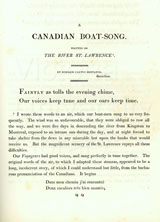A pretty air without words resembles one of those half creatures of Plato, which are described as wandering in search of the remainder of themselves through the world. To supply this other half, by uniting with congenial words the many fugitive melodies which have hitherto had none,--or only such as are unintelligible to the generality of their hearers,--is the object and ambition of the present work.
— From the Advertisement to National Airs
Building upon his success with the popular and very lucrative Irish Melodies (1808-1834), Moore sought to expand the franchise with National Airs (1818-27). The series included a large number of lyrics, ostensibly set to folk tunes described as Spanish, Indian, Hungarian, Russian, and Swedish, among others.
Painting is lifeless; and the most burning words of poetry have all been lavished upon inferior and ordinary subjects. We must have new combinations of language to describe the Falls of Niagara.
— Thomas Moore (1779-1852)
From September 1803 to November 1804, the Irish poet Thomas Moore travelled in North America, visiting places as various as Bermuda, New York, Quebec, and Halifax. While travelling by boat on the St. Lawrence between Kingston and Montreal, Moore heard French-Canadian voyageurs singing “Dans mon chemin j’ai rencontré.” On his return to England, he published a version of the air, though it resembled the original only in its opening bars. As would later become his modus operandi in Irish Melodies and National Airs, he wrote his own words to the melody. As for the original French words, according to Moore they “appeared to be a long, incoherent story.” For authenticity, he turned to Sir Alexander Mackenzie’s descriptions of his explorations to supply the details about the Rapids of St. Anne. The song remained hugely popular during the nineteenth century and provided for many their first—and often only—experience of Canada.





